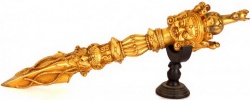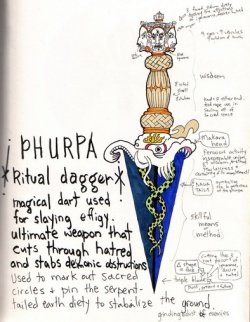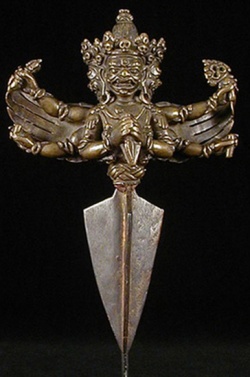Notes on the Phur-bu
The Tibetan ritual object called phur bu or phur pa—a kind of dagger—has been the topic of some learned articles and a beautifully illustrated book. But so far I do not notice a satisfactory solution for the term phur bu itself. Let me consider the entry in a native Tibetan dictionary based on syllables, namely, Jampa Chogyal's Dag yig ma nor lam bzaṅ (Jayyed Press, Delhi, 1969), p. 301, phur: lcags kyi phur bu / gza' phur bu / phye ma phur ma /. He illustrates the Tibetan syllable phur by "iron phur bu" (i.e. the dagger), "planet phur bu" (i.e. the planet Jupiter), and "powder phur ma" (i.e. powder, possibly medicinal). Of course, the entries do not exhaust the possibilities. For example, the dagger form does not have to be made of iron. Now, it is known that the dagger phur bu regularly translates the Sanskrit kīla ('nail'), while the planet phur bu translates the proper name Āṅgirasa (in the dictionary Amarakosa and its Tibetan translation, verse I, 91). The Vedic name Āṅgirasa is a derivative word, 'descendent of Āṅgiras;' so this helps explain the bu of phur bu, because bu means 'son (of)'. Now Dowson (A Classical Dictionary of Hindu Mythology, p. 16) points out the 'Atigi' (of Angiras), possibly because it sounds like Agni (the Fire God), was associated with fire; this forces the ras to be construed as rasa, the juice or motive force, so what keeps the fire going. To see this as the reason for the Tibetan translation, we must go to the parallel Tibetan word sbur; so in the Sanskrit-Tibetan Buddhist dictionary Mahāvyutpatti (Sakaki ed., no. 6703), the entry S. paritta-sakalikāgnih; T. sbur ma'i me chutz nu 'slow fire kept up by tiny pieces of wood'. Besides, Jampa Chogyal's dictionary, p. 324, gives for sbur the noun sbur ma for tiny creatures like ants, and also the fungus-dust afflicting fruit trees. There is no doubt that this sbur ma like phur ma means tiny things, particles, ants, etc., and that phur in the name of the planet Jupiter means the small pieces of fuel to keep a slow fire going, and that bu was added in the sense of 'son'. This shows that the phur in phur bu used for the dagger must be a different word, but a homonym of the phur that means particles. To determine the other phur that translates Sanskrit kila, one should observe that nailing here means binding or tying down, as will be shown below. Hence, we go to the parallel Tibetan word bur (see Sarat Chandras Das' Tibetan dictionary, p. 874) which means 'bolt or fastening to a door.' This suggests that the correct form of the term is phur pa rather than phur bu, and that the switch to the bu syllable came through confusion with the name of the planet Jupiter. However, since the term phur bu is frequently used to translate kīla, we can say it has the correctness of usage.
An article by Meredith' on the Tibetan magic dagger introduces the reader to the theories of Siegbert Hummel, Giuseppe Tucci, and others; and has some photographs of the phur bu by courtesy of the Field Museum of Natural History in Chicago. I suppose this author did not originate the association with an arrow, but this should be rejected, since the arrow symbolizes alien penetration or temptation (confer: Kāmadeva's flowery arrows); and in the Tibetan Wheel of Life, the seventh member, feelings (vedanā) (as the bondage of karma) is illustrated by an eye struck with an arrow. Besides, as will be shown below, the phur bu dagger represents a downward force, which is implied by the information which Meredith supplies from Hummel that Padmasambhava consecrated the ground of the Tibetan monastery Samye (Bsamyas) "by stabbing a phur bu into the earth."
For the Indian Buddhist use of the term, with phur bu equivalent to kīla, I refer to Asafiga's Yogācārabhūmi in the exegesis section called Vastusamgraharti (Japanese photo. edition of Kanjur-Tanjur, Vol. 111, p. 131-4-4), in a discussion of 'bondage' (bails): "Here the bondage of sugati-karma (karma of good destiny) is like the post (stambha) of sugati; the bondage of durgati-karma (karma of bad destiny) is like the dagger (kīla) of durgati." [1] Notice that the movement to good destiny is upward, like a post; and that the movement to bad destiny is downward, like a dagger plunged into the ground. Of course, the early use of the term is quite in-dependent of the later ritual phur bu, except for the 'downward' and the binding' connotations. A useful article by Stein' mentions various tantric sources; but not the one I know about, in the Kriyā Tantra cycle of Vajrapāni, namely, the Vajravidārarja-dhārani with a number of ritual commentaries in the Tanjur. I long ago translated the rather brief Dhārarzi with the help of the commentary by Buddhaguhya (eighth century) called Ratnābhāsvāra-nāma in the Derge Kanjur-Tanjur versions.' The point is that there are four deities in Vajrapāni's immediate retinue, Vajrakīla, Vajradanda, Vajramudgara, and Vajracanda. The well-known formula kīlikīlāya is employed in the mantras of the first two, to wit, mantra of Vajrakīla: curu curu candakīlikīlāya svāhā; and mantra of Vajradanda: trāsaya trāsaya vajrakīlikīlāya svāhā. For translating these, one may notice that kīlāya would be taken in Classical Sanskrit as a dative, but may be taken in Middle Indic (cf. Edgerton, Buddhist Hybrid Sanskrit Grammar, p. 52, para. 8.42) if the context demands it, as an instrumental. So construing these, we may translate Vajrakīla's mantra: "Steal (it), steal (it), with the furious kīlikīla (magic fetter), Svāhā." And Vajradanda's mantra: "Frighten (them), frighten (them), with the diamond kīlikīla, Svāhā." Later, for the four magical acts (for appeasing, prosperity, controlling, and overpowering), the Dhāranī gives Vajrakīla's prosperity upahrdaya: hulu hulu; and Vajradanda's appeasing upahrdaya: tistha tistha vajra. We note that in Sanskrit the word hula is a kind of dagger, so Vajrakīla's mantra for prosperity magic can be translated "Transfix (it), transfix (it)!" Also noting that danda is the retribution rod, Vajradanda's mantra for appeasing magic can be translated "Stand up, stand up, 0 Vajra!" Notice how this accords with the two movements mentioned by Asanga: prosperity magic is directed downward toward earth; appeasing the gods requires an upward movement. As to the expression upahrdaya, this is a mantra that is next to the shortest length, the syllable, referred to as a hrdaya.
Now the Buddhist master Asanga also has a long list of similes for 'insight' (prajñā, Tib. śes rab), wherein he mentions the "stake of insight" used against the four Māras, from the defilement kind, to the Son-of-the-Gods kind.' The Tibetan for 'stake' is mtshon cha (=Skt. śastra, 'dagger') in the text at Photo. ed of Tanjur, Vol. 111 p. 232-3-2,3. This shows that even at his early date (4th-5th A.D.) the notion was there, applied to the evil deity called Mara or his messengers, but not in his case using the term kila. In tantric rituals this is part of the mandala rite called "protecting and blessing the site;" it requires the hierophant to identify himself with a certain wrathful deity (krodha) and command the obstructing demons to depart; the remaining ones are nailed down with the magic nail (kīla).5 "Nailing down" we have come to see, by suggestion of Asanga's writings, is associated with "binding." This is confirmed in the article by Bischoff and Hartman,' including in their translation of the Pelliot Ms, "as for the proper nature (svabhāva) of the Dagger, (visualize) the slip knot."
These considerations should serve a conclusion that the basic theories of this phur bu were developed in India, and came into Tibet by way of both non-tantric and tantric Buddhism, as was alluded to above. However, there is no doubt that the theory underwent a further and rich development in Tibet, starting with the ritual objects. The tradition says that Padmasambhava invented the phur bu. This means the phur bu or phur pa as an object of which we can now take photographs. When there are three faces on the phur bu they remind us of the khatvanga, Padmasambhava's magic wand. In contrast, the Tibetan danda (Tib. dbyug pa or chad pa), the retribution wand, is surmounted by a single (possibly grinning) face, the lower end possibly having a vajra. Part of this Tibetan development was the association of the deity Hayagrīva, or Tamdin in Tibetan pronunciation, with the phur bu. Mahāyānists worshipped Hayagrīva ('horse-necked') about 500 A.D. This is a horse-headed form of Avalokiteśvara in which role he is called "best of all horses" (paramāśva). The word for horse (āśva) lends itself for (false) etymological connection with aś- 'to eat,' so Hayagrīva devours his enemies, the demons. In Tibet, the form with wings of the Gan* bird was popular among the Rñiṅ-ma-pa; and the Fifth Dalai Lama, who combined Rñiṅ-ma-pa with Gelugpa lineages, wrote treatises on the Yangsan (atiguhya) form of Hayagriva, whose history is related in a terma book said to have been discovered at the rock of Yerpa in Lhasa.7 Besides, the planet Jupiter deserves a comparison mention. His Sanskrit name is Brhaspati (master of the ritual formulas), and in classical times he was the "guru of the gods" while the planet Venus (Sukra) was guru of the Daityas, demonic enemies of the gods; cf. Amarakosa (Sanskrit-Tibetan edition, I, 91-92). Now, Hayagriva is lord of spells (vidyārāja) and animator of the large three-edged dagger (vajrakīla) which nails down the demons. This is merely a surface similarity, but may help explain why the phur bu translation of Jupiter's alternate name largely pushed out the more correct phur pa for kīla. It should be mentioned that Hayagriva is not the only deity identified with the phur bu. Stein's article shows his considerable interest in the identification of Amrtakundali with Vajrakīla in the Guhyasamājatantra lineage of its Chap. 13 and 14, and the connection with the ten krodha deities, including Amrtakundali;8 and he has also gone into this matter in his Bonn lecture.9 While I also treated the ten krodha of the Guhyasamāja in terms of their directions, position in the body, and the kinds of demons respectively destroyed by each, I did not go into the matter of the phur bu.10 The tantric commentator Bhavyakīrti has much to say about this in the introductory section to his commentary on the Pradīpoddyotana, itself a commentary on the Guhyasamājatantra by the tantric Candrakīrti. Bhavyakīrti presumably refers to the section toward the end of Guhyasamāja, Chap. 14, by his remarks in Photo ed. of Kanjur-Tanjur, Vol. 61, p. 71. Here (p. 71-3-4) he says: "At the time of fastening (demons) with the magic dagger (phur bu), one should contemplate the ten fury deities (krodha) like Bhagavat Amrtakundali, i.e. like the blue lotus, because Amrtakundali is all the ritual acts (karma, i.e. for magical results)." [2] And he says (p. 71-4-2): "One should contemplate Vajrakīla as the nature (svabhāva) of the ten krodha kings." [3] Again (p. 71-4-7): "When one restrains (them) with the vajrakīla, the bodies of the demons are said to be motionless." [4] Since mandala theory requires the mandala in the mind to precede the outer mandala made of powdered colors," etc., it follows that the subjective mandala ritual should be taken for granted to understand his remark (p. 71-5-6): "holding down with the magic dagger dispels all constructive thought." [5] While explaining the mantras that precede Guhyasamāja, 14, k. 59, Bhavyakīrti says (p. 71-5-3) that kīlaya, (the first one) is the imperative "May (they) attain with the kīla at the crown of the head!" [6] He says (p. 71-5-4) that the next kīlaya, but in compound with vajra, is the vocative "0 ten krodha." [7] He says (p. 71-5-5) that the last kīlaya, also in compound with vajra, is the imperative" May they differentiate (i.e. body, speech, and mind)." [8] Soon this author says (p.71-5-8): "Besides, it is the precept called 'nature of Hayagrīva'."[9]
It remains to speak briefly about the book on the topic by Huntington .12 This is invaluable for its wealth of illustrations. The discussion covers such scholarly sources as Wojkowitz, Oracles and Demons of Tibet. It was of course correct for the author to use generally the term phur pa, although admittedly the usual Tanjur passages containing the translation of kīla (dagger, nail) or kīlana (holding down with the dagger, nail) exhibit the form phur bu. Huntington's illustrations are a corrective for seeing a particular phur bu (or, phur pa) in a museum and thinking that now we know what it looks like, because he has a remarkable variety in his figures.13 I suppose there is a danger of including too many different objects under the phur pa heading; but he of course knows that the phur pa is different from the khatvānga, the danda, and the sword (T. ral gri). I should prefer to conclude, on the basis of the findings in these notes, that the phur pa has a down-pointing three-edged blade and is necessarily down-pointing due to the orientation of the face or faces of a head on top."
For the Rñiṅ-ma-pa to have subjected this notion and its ritual implementation to such a flourishing native Tibetan development, suggests that we have in this phur bu one of those sensitive points of Indo-Tibetan religious practice and symbolism that warrants the scholarly treatment here and elsewhere.
NOTES
1. Georgette Meredith, "The Phurbu: the Use and Symbolism of the Tibetan Magic Dagger," History of Religions, 6:3, Feb. 1967, pp. 236-253.
2. R. A. Stein, "A propos des documents anciens relatifs au phur-bu (kīla)," Proceedings of the Csoma de Korös Memorial Symposium, held at Matrafüred, Hungary 24-30 September 1976, ed. by Louis Ligeti (Akademiai Kiado, Budapest, 1978), pp. 427-444.
3. So far I have not published my studies on this Dhāranī; however, I made a long note from the material for Ferdinand D. Lessing and Alex Wayman, Mkhas grub rje's Fundamentals of the Buddhist Tantras (The Hague, 1968), pp. 116-118, within which I gave Vajrakīla's individual mantra, repeated in the present paper.
4. For Asanga's list, cf. A. Wayman, "Nescience and Insight according to Asanga's Yogācārabhūmi," in Buddhist Studies in honor of Walpola Rahula (Gordon Fraser, London, 1980), pp. 260-262.
5. Mkhas grub rje's Fundamentals, p. 283.
6. F. A. Bischoff & Charles Hartman, "Padmasambhava's invention of the phur-bu, Ms. Pelliot tibetain 44," in Etudes tibetaines dediees a la memoire de Marcelle Lalou (Paris, 1971), pp. 11-28.
7. Cf. A Catalogue of the Tohoku University Collection of Tibetan Works on Buddhism, published by The Seminary of Indology, Tohoku University, 1953, Nos. 5749-5754, in collected works of Nag-dban rgya-mtsho, Dalai-Lama V, Vol. Ga.
8. Cf. Stein, "A propos .. ." p. 434.
9. L'Annuaire du College de France, 78e annee, Resume des cours et travaux de de l'annee scolaire 1977-1978, pp. 647-654.
10. A. Wayman, Yoga of the Guhyasamājatantra; the Arcane Lore of Forty Verses (Delhi, 1977), pp. 243-4.
11. A. Wayman, The Buddhist Tantras; Light on Indo-Tibetan Esotericism (New York, 1973), p. 83, citing from the Sarvarahasya-nāma-tantrarāja the verse "Where the mandala is explained is the sublime mental mandala. The palace is knowledge (jñāna), erection of an edifice of consciousness."
12. John C. Huntington, The Phur-pa, Tibetan Ritual Daggers (Artibus Asiae Supplementum XXXIII, Ascona, Switzerland, 1975).
13. Huntington, The Phur-pa, shows many convincing examples of the phur-pa, some surmounted with a single face, some with multiple faces, some with upper torso of body, and some with whole body of deity on top. In some cases, there is a simple design without a deity face or faces. We find it held, e.g. in Fig. 6, Phur-pa yab-yum. An impressive depiction of the deity Phur-pa is in Fig. 70, "The tutelary of the rNying-ma-pa," also said to be Padmasambhava as "Fierce Guru with Phur-pa."
14. Hence, Huntington, The Phur-pa, Fig. 68, with the upward-pointing blade, is not a phur pa. Indeed, the author himself, p. 45, includes it with reservations, suggesting that it is a fake.
Source
Author: Wayman, Alex
Journal of the Tibet Society, Volume 1, 1981, p. 79-85
Retrieved from http://www.dspace.cam.ac.uk/handle/1810/227118



